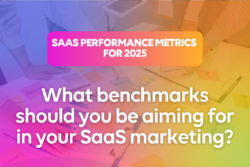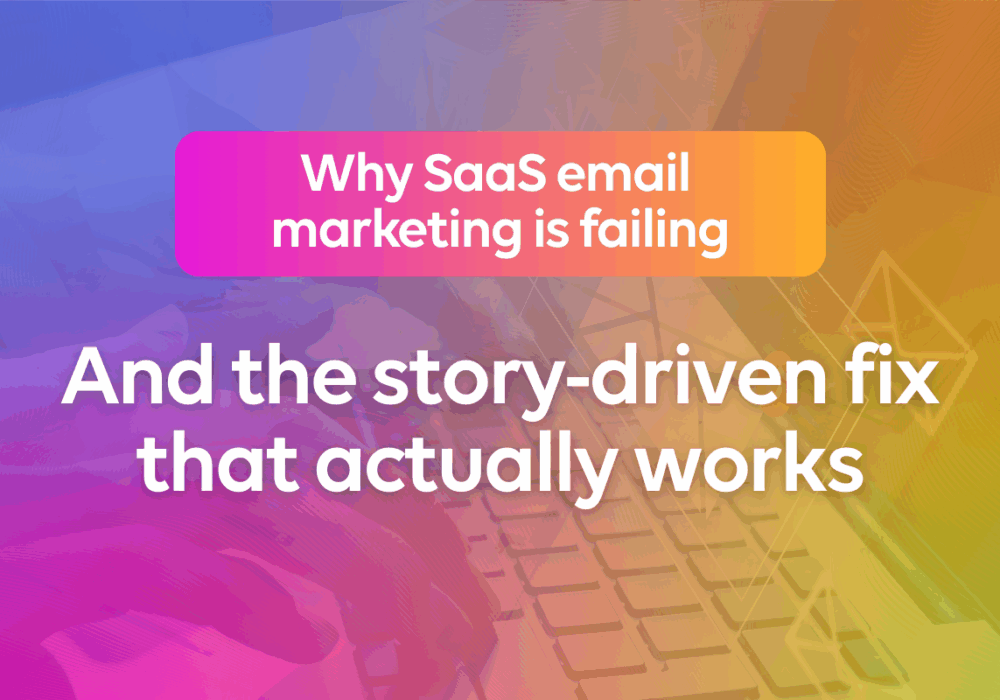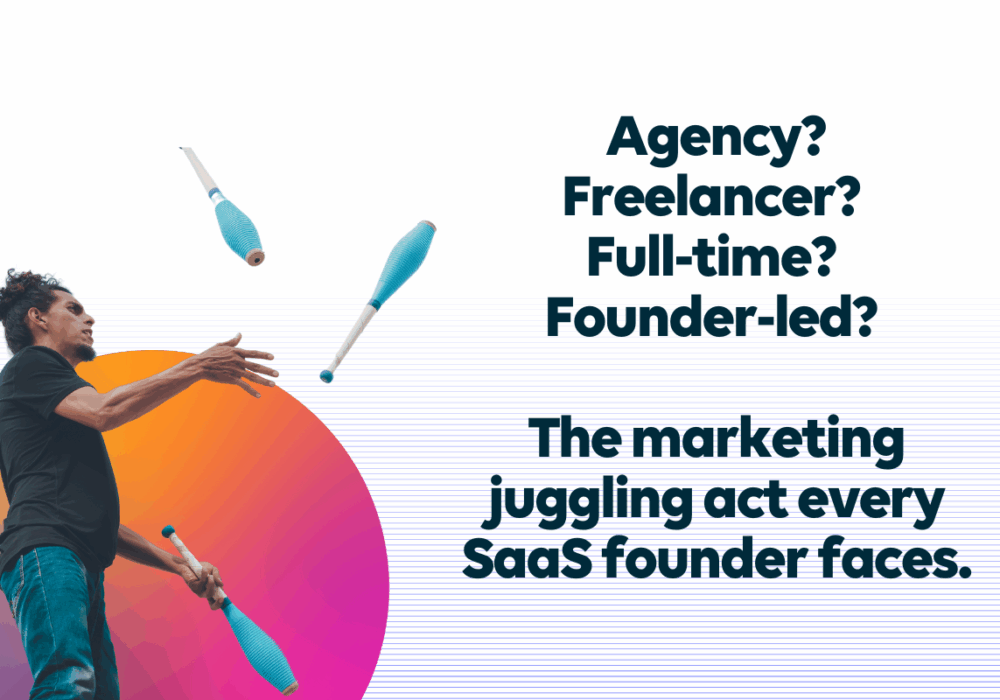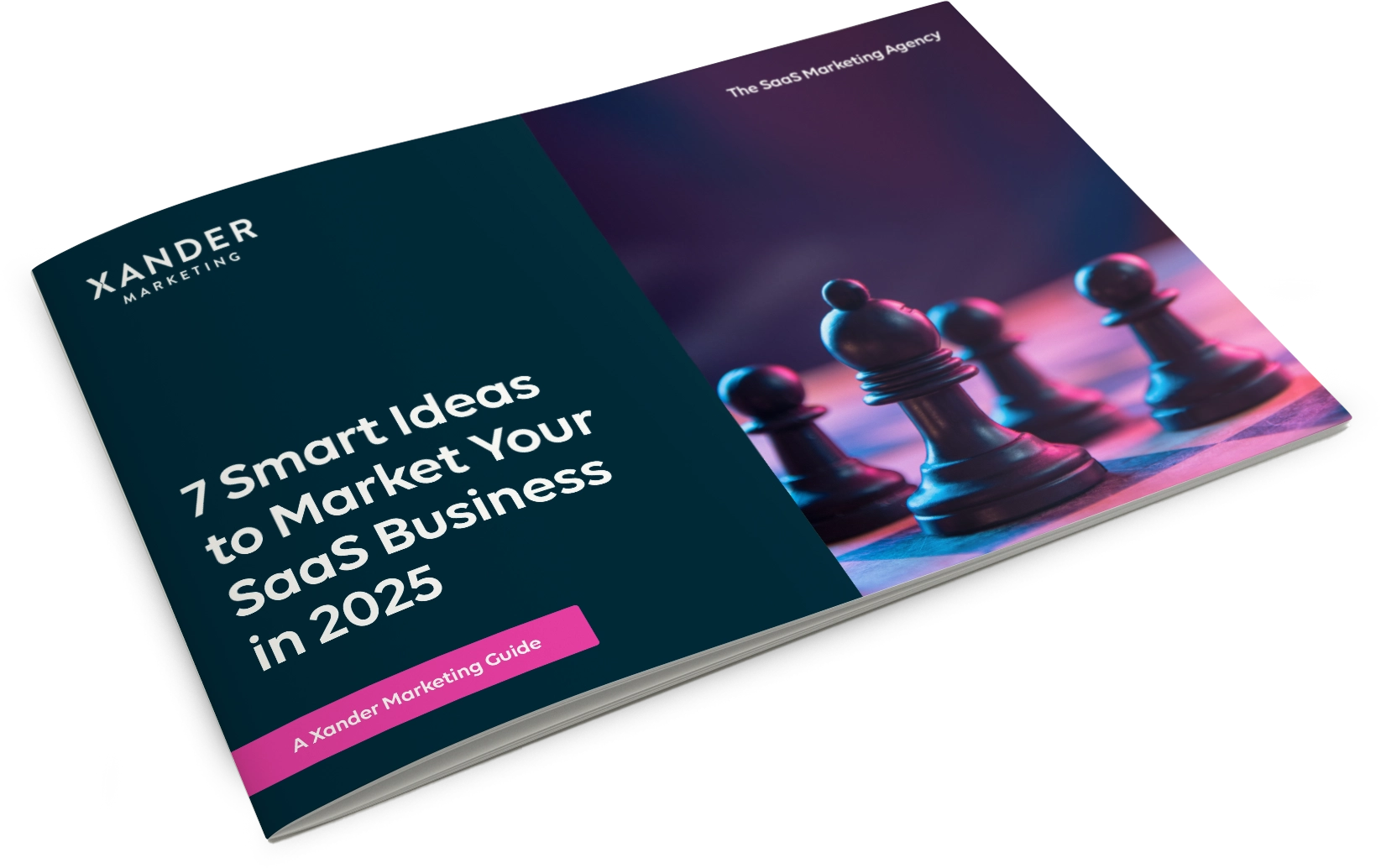What benchmarks should you be aiming for in your SaaS marketing?
19th May 2025

Before going on any journey, you need to know your starting point and destination. The same principle applies to your SaaS marketing strategy: understanding where your business currently stands and what you aim to achieve is essential for success.
SaaS marketing benchmarks provide a logical framework to compare your performance against industry averages and create realistic goals. These benchmark metrics form the foundation for data-driven targets that effectively measure your ongoing success.
When setting goals for your SaaS business, you’ll likely encounter an overwhelming array of metrics. The key is selecting a focused set of indicators that align with your specific business objectives and can be easily tracked, measured, and compared to industry standards.
In this updated guide for 2025, we’ll explore the latest SaaS marketing benchmarks across key channels, examine how AI is reshaping these metrics, and highlight emerging trends every SaaS marketer should monitor.
Key SaaS Marketing Benchmarks in 2025
CAC to LTV Ratio
Customer Acquisition Cost (CAC) and Lifetime Value (LTV) remain fundamental metrics for SaaS businesses. The relationship between these figures reveals how much added value each customer brings to your business, and therefore how much you can afford to spend on acquisition.
Current benchmarks:
- The ideal LTV ratio remains 3:1 – meaning for every £1 spent on acquiring a new customer, you should aim to generate at least £3 in lifetime revenue
- The actual median for SaaS companies in 2025 hovers between 2.5:1 and 3:1
- Industry variations exist: business services typically see lower ratios (around 3:1), while marketing services can achieve up to 10:1
CAC Payback Period:
- The median payback period is approximately 15 months
- A healthy range falls between 12-18 months
- Top-performing startups strive for under 12 months
Factors to consider:
- Be patient with new investments. If you’ve recently expanded into a new region or increased spending on long-term tactics like content marketing, these efforts take time to generate results.
- Consider context. The CAC metric is only meaningful when compared with your LTV. A £100 CAC might initially seem reasonable if a new customer spends £100 in year one, but without strong retention, this becomes problematic, especially since acquiring new customers costs more than retaining existing ones.
- Get granular with your analysis. Ideally, you should calculate CAC for each marketing channel to identify where your acquisition costs are lowest and allocate budgets accordingly.
Website Conversion Rates
Website conversion rate – the percentage of visitors who take a desired action – reveals how effectively your content and user experience guide quality leads toward conversion.
Current benchmarks:
- Average website visitor-to-lead conversion rate for B2B SaaS: 2-3%
- Target rate to aim for: 5% (achievable with focused optimisation)
- Top performers with optimised user journeys can reach 5-10%
Factors to consider:
- Define what constitutes a conversion. Starting a free trial or booking a demo represents a stronger lead than downloading a white paper, though both should be tracked. Consider breaking down your website conversion benchmark into qualified leads, lead-to-trial conversions, and trial-to-paying-customer conversions.
- Monitor your bounce rate. This indicates how many visitors leave after viewing just one page. The average bounce rate for B2B SaaS is around 75%. If yours is significantly higher, you need to improve navigation and engagement elements to guide visitors further into your funnel. (unless it’s a landing page!)
- Assess traffic quality. The relevance of your website traffic is crucial – attracting the wrong audience will inevitably result in lower conversion rates, regardless of your site’s quality.
Email Marketing Performance
Despite the proliferation of new channels, email remains a workhorse for B2B SaaS marketing in 2025. Recent privacy changes (like Apple’s Mail Privacy Protection) have affected tracking, but clicks still provide reliable engagement data. According to this recent blog from Promodo:
Current benchmarks:
- Open rates for B2B software/SaaS marketing emails: 20-25%
- Note: Due to privacy features auto-loading images, recorded open rates may appear inflated (often 30%+). Focus more on clicks and downstream actions for accurate engagement measurement.
- Click-through rates (CTR): 2.5-3.5% on average
- Click-to-open rate (CTOR): 10-15% (indicating that about one in ten opens leads to a site visit)
Factors to consider:
- Evaluate your content strategy. If open rates meet targets but click-through rates lag, your email content may not resonate with your audience or contain compelling calls to action.
- Adjust expectations for cold vs. warm outreach. Cold emails typically have lower open and click-through rates than communications to an opted-in list. Set different benchmarks for each approach.
- Personalise your communications. Personalised emails consistently deliver higher open rates, especially when combined with marketing automation for targeted content delivery based on behaviour, lifecycle stage, or user preferences.
PPC/Google Ads Performance
Paid search remains essential for SaaS demand generation, with specific performance indicators you should monitor closely.
Current benchmarks:
- Click-through rate (CTR) for Google Search ads targeting B2B SaaS keywords: 2-3%
- Well-optimised campaigns can achieve 3-5% CTR for top-of-page ads
- Display ads typically have much lower CTRs (around 0.5% or below)
- Cost per click (CPC) for B2B SaaS keywords: £3-£6 in the UK (slightly lower than US averages of $3-$6)
- Highly competitive enterprise software keywords can exceed £8 per click
- Conversion rate from click to lead or trial: 2-5% (average around 3%)
- Higher-intent keywords can see conversion rates of 5-10%
- Return on ad spend (ROAS): 3:1 to 5:1 is considered good for B2B SaaS
- Target: £3-£5 in lifetime revenue for every £1 in ad spend
Sources:
https://www.adlabz.co/b2b-saas-google-ads-benchmarks-for-2025
https://www.gartner.com/en/marketing/topics/ai-in-marketing
Factors to consider:
- Multiple variables affect performance. Your PPC benchmarks will be influenced by the advertising platform, ad type, target audience, keyword competitiveness, product category, and bidding strategy.
- SaaS keywords can be expensive. Some keywords see prices as high as £80. Google Ads often have high upfront costs, and you may initially lose money on customer acquisition while testing and optimising campaigns.
- Prioritise quality over quantity. Focus on attracting the right customers through PPC to ensure your spending delivers value. Fine-tuning campaigns to target high-quality prospects may reduce conversion rates initially but will yield lower churn and higher lifetime value over time.
Organic Search (SEO) Performance
Organic search remains the largest source of traffic and leads for many B2B SaaS companies in 2025, with significant implications for your marketing strategy.
Current benchmarks:
- Organic search typically accounts for 50%+ of SaaS website traffic
- Far outpacing channels like paid search (~15%) or social media
- SEO conversion rates: Visitors from organic search convert to leads at approximately 2-3%
- While similar to overall site conversion rates, SEO leads tend to have higher quality
- SEO leads have an average 14.6% close rate (compared to just 1.7% for outbound leads)
- SERP rankings impact: Position #1 receives 28-30% of clicks, while position #10 gets only about 2%
- Less than 1% of searchers click results on page 2
Factors to consider:
- Keywords drive traffic and conversions. Long-tail keywords often deliver better SEO results than general terms, as they target users with specific intent.
- Content quality matters more than ever. Google increasingly prioritises high-quality, well-written, and well-organised content. Avoid keyword stuffing and focus on creating genuinely valuable resources for your audience.
- Stay informed about algorithm changes. Google continuously updates its search algorithms and SERP features. Keeping abreast of these changes helps you adapt your SEO strategy to maintain or improve rankings.
How AI is Transforming SaaS Marketing Benchmarks
AI has become a game-changer for SaaS marketing, influencing traditional metrics and introducing new performance indicators.
AI’s Impact on Traditional Metrics
Improved targeting and lower CAC:
- AI-powered ad platforms use machine learning to optimise targeting and bidding in real-time
- Marketers using AI-based bidding have seen up to 20% more conversions at similar costs
- This efficiency translates to improved LTV ratios and shorter payback periods
Enhanced email performance:
- AI personalises email send times for individual recipients based on past engagement patterns
- AI-generated subject lines can boost open rates by 5-15% in A/B tests
- Smart segmentation algorithms deliver more relevant content, increasing click-through rates
Optimised ad creative and higher CTR:
- Dynamic ad generation tests multiple headlines and images to serve the best-performing combinations
- AI-generated ad copy variations can improve CTR by up to 30% compared to manually crafted ads
- The continual optimisation pushes industry benchmarks higher over time
SEO and content evolution:
- AI content tools enable marketers to produce optimised content at scale
- AI-powered search results (featured snippets, conversational answers) affect click behaviour
- SEO professionals now focus on content that AI is likely to cite as authoritative
Improved lead scoring and conversion rates:
- AI-driven lead scoring identifies prospects with the highest propensity to convert
- More efficient lead prioritisation improves MQL-to-customer conversion rates
- Marketing teams are now measured on lead quality, not just quantity
New AI-Driven Metrics to Monitor
As AI becomes integral to marketing operations, several new metrics have emerged:
- AI Content Performance: Comparing engagement, conversion rates, and SEO rankings of AI-generated content versus human-created content. Some organisations track “AI Content Yield” to measure how efficiently AI content creation translates into traffic or leads.
- Prompt Optimisation Efficiency: Measuring how many iterations it takes to get usable content or how different prompt approaches correlate with content success. Advanced teams track “Prompt Success Rate” – the percentage of AI outputs usable without heavy editing.
- AI Engagement Metrics: For teams using AI chatbots or assistants, metrics like “Chatbot Conversion Rate” (percentage of bot interactions that convert to leads) have become standard.
- Efficiency and Productivity Gains: Measuring time savings or output increases attributable to AI tools, such as reduced content creation time or increased content volume without additional headcount.
Emerging Channels and Metrics for SaaS Marketing
Several new channels and metrics have gained significant traction since 2023:
New Marketing Channels
AI-Powered Conversational Marketing:
- AI chatbots have become mainstream on B2B websites
- Approximately 45-50% of B2B businesses now use chatbots, up from 20% a few years ago
- These tools capture leads that might not complete traditional forms and provide 24/7 engagement
Short-Form Video on New Platforms:
- B2B SaaS marketers increasingly leverage TikTok, Instagram Reels, and YouTube Shorts
- 15-25% of B2B SaaS marketers now use TikTok as part of their strategy
- These channels reach decision-makers in more informal, creative contexts
Community-Led Marketing:
- Many SaaS companies now build and nurture user communities on Slack, Discord, or independent forums
- These spaces allow prospects to interact with customers and get value before buying
- Community management has become a standard role within marketing teams
AI-Enhanced Search Optimisation:
- As AI assistants (like Bing Chat and Google’s Search Generative Experience) become common interfaces to information
- Forward-looking teams optimise for “Answer Engine Optimisation” – being the referenced source when a user asks an AI about solutions in your category
New Standard Metrics
Several metrics that were niche in 2023 have become standard by 2025:
Marketing Qualified Accounts (MQA):
- Replacing or complementing MQLs, this metric looks at account-level engagement
- Reflects the multi-stakeholder nature of B2B sales
- Focuses on quality engagement rather than individual lead volume
Pipeline Velocity and Attribution:
- More sophisticated multi-touch attribution models, often AI-powered
- Analysis of how quickly leads move through the funnel by channel or content sequence
- Direct connection between marketing efforts and revenue generation
Customer Lifecycle Metrics:
- Marketing teams now often share responsibility for Net Revenue Retention (NRR)
- Metrics like “campaign-attributed expansion ARR” track marketing’s impact on existing customer growth
- Reflects the industry’s focus on customer retention and expansion
Content Engagement Depth:
- Beyond simple downloads or views, teams measure actual engagement with content
- Metrics like “content engagement score per lead” track multiple interactions across formats
- Performance of diverse content types (blogs, videos, podcasts) each have their own KPIs
Bringing It All Together: Setting Realistic Benchmarks
With the wealth of metrics available, how do you determine which benchmarks matter most for your SaaS business?
Align metrics with your business stage and goals
- Early-stage startups may focus more on lead generation and conversion rates
- Scale-ups might prioritise CAC ratio and pipeline velocity
- Enterprise-focused SaaS might emphasise account-based metrics and customer expansion
Start with industry averages, then customise
- Use the benchmarks in this article as a starting point
- Adjust expectations based on your specific niche, pricing model, and target market
- Set incremental improvement goals rather than trying to leap to top-performer status immediately
Consider the interconnected nature of metrics
- Recognise that improvements in one area affect others (e.g., better content quality improves both SEO and conversion rates)
- Take a holistic approach to optimisation rather than focusing on isolated metrics
- Identify root causes when metrics underperform expectations
Embrace AI as a strategic advantage
- Leverage AI tools to improve efficiency and performance across channels
- Track both traditional metrics and new AI-specific indicators
- Use AI analytics to identify patterns and opportunities that might be missed otherwise
The Future of SaaS Marketing Benchmarks
As we’ve seen, SaaS marketing benchmarks continue to evolve, influenced by technological advances, changing buyer behaviours, and competitive pressures. The rise of AI, new social platforms, and community-focused approaches has introduced both challenges and opportunities for marketers aiming to measure success effectively.
While the specific numbers may shift, the fundamental principles remain: understand your starting point, set clear destination goals, measure progress consistently, and adapt strategies based on data-driven insights.
The most successful SaaS marketers in 2025 will be those who not only track the right metrics but use them as a compass to guide intelligent decision-making. They’ll balance traditional performance indicators with emerging metrics, maintaining a focus on the fundamentals while embracing innovation.
Grow Your SaaS Business with Xander Marketing
Whether you need support developing a metrics-driven marketing strategy or help improving your performance across key channels, Xander Marketing is the proven outsourced partner for B2B SaaS businesses.
With experience working with over 200 SaaS businesses since 2009, Xander Marketing can help you establish the right benchmarks for your business and implement strategies to exceed them. We understand the unique challenges of SaaS marketing and leverage both proven techniques and cutting-edge approaches to drive results.
We’re a perfect fit for B2B SaaS businesses with no in-house marketing team or marketing managers who need a skilled delivery partner.
Get in touch today and book your free 30-minute consultation to discuss how we can help you meet and exceed the benchmarks that matter most for your SaaS business.





